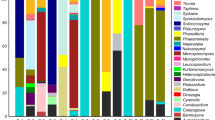Abstract
Thirteen undescribed strains of ballistoconidium-forming yeasts, isolated from leaves collected in the suburbs and along the southeast seacoast of Bangkok, Thailand, were divided into four different groups in the genusSporobolomyces on the basis of morphological, physiological, biochemical, and chemotaxonomical characteristics, and analyses of the sequences of 18S rDNA and internal transcribed spacer regions. DNA-DNA reassociation experiments with related species revealed that these four groups were four new distinct species.Sporobolomyces nylandii sp. nov.,S. poonsookiae sp. nov.,S. blumeae sp. nov. andS. vermiculatus sp. nov. are proposed for these strains.
Similar content being viewed by others
Literature cited
Boekhout, T. 1991. A revision of ballistoconidia-forming yeasts and fungi. Stud. Mycol.33: 1–194.
Boekhout, T. and Nakase, T. 1998.Sporobolomyces Kluyver & van Niel. In The Yeasts, A Taxonomic Study, 4th ed. (ed. by Kurtzman, C. P. and Fell, J. W.), pp. 828–843. Elsevier, Amsterdam.
Fell, J. W., Blatt, G. M. and Statzell-Tallman, A. 1998. Validation of the basidiomycetous yeast,Sporidiobolus microsporus sp. nov., based on phenotypic and molecular analyses. Antonie Leeuwenhoek J. Microbiol.74: 265–270.
Felsenstein, J. 1985. Confidence limits on phylogenies: An approach using the bootstrap. Evolution39: 783–791.
Hamamoto, M. and Nakase, T. 1995. Ballistosporous yeasts found on the surface of plant materials collected in New Zealand. 1. Six new species in the genusSporobolomyces. Antonie Leeuwenhoek. J. Microbiol.67: 151–171.
Hamamoto, M. and Nakase, T. 2000. Phylogenetic analysis of the ballistoconidium-forming yeast genusSporobolomyces based on 18S rDNA sequences. Int. J. Syst. Evol. Microbiol.50: 1373–1380.
Kimura, M. 1980. A simple method for estimating evolutionary rate of base substitutions through comparative studies of nucleotide sequences. J. Mol. Evol.16: 111–120.
Komagata, K. and Nakase, T. 1967. Microbiological studies on frozen foods. V. General properties of yeasts isolated from frozen foods (in Japanese). J. Food Hyg. Soc. Japan8: 53–57.
Nakase, T. and Suzuki, M. 1986.Bullera megalospora, a new species of yeast forming large ballistospores isolated from dead leaves ofOryza sativa, Miscanthus sinensis, andSasa sp. in Japan. J. Gen. Appl. Microbiol.32: 225–240.
Nakase, T. and Takashima, M. 1993. A simple procedure for the high frequency isolation of new taxa of ballistosporous yeasts living on the surface of plants. RIKEN Review3: 33–34.
Raeder, U. and Broda, P. 1985. Rapid preparation of DNA from filamentous fungi. Lett. Appl. Microbiol.1: 17–20.
Saitou, N. and Nei, M. 1987. The neighbor-joining method: A new method for reconstructing phylogenetic trees. Mol. Biol. Evol.4: 406–425.
Statzell-Tallman, A. and Fell, J. W. 1998.Sporidiobolus Nyland. In: The Yeasts, A Taxonomic Study, 4th ed. (ed. by Kurtzman, C. P. and Fell, J. W.), pp. 693–699. Elsevier, Amsterdam.
Sugita, T. and Nakase, T. 1999. Non-universal usage of the leucine CUG codon and the molecular phylogeny of the genusCandida. Syst. Appl. Microbiol.22: 79–86.
Sugita, T., Nishikawa, A., Ikeda, R. and Shinoda, T. 1999. Identification of medically relevantTrichosporon species based on sequences of internal transcribed spacer regions and construction of a database forTrichosporon identification. J. Clin. Microbiol.37: 1985–1993.
Suzuki, M. and Nakase, T. 1988. The distribution of xylose in the cells of ballistosporous yeasts—Application of high performance liquid chromatography without derivatization to the analysis of xylose in whole cell hydrolysates. J. Gen. Appl. Microbiol.34: 95–103.
Tamaoka, J. and Komagata, K. 1984. Determination of DNA base composition by reversed-phase high-performance liquid chromatography. FEMS Lett.25: 125–128.
Thompson, J. D., Higgins, D. G. and Gibson, T. J. 1994. CLUSTALW: Improving the sensitivity of progressive multiple sequence alignment through sequence weighting, position-specific gap penalties and weight matrix choice. Nucleic Acids Res.22: 4673–4680.
van der Walt, J. P. and Yarrow, D. 1984. Methods for the isolation, maintenance, classification and identification of yeasts. In: The Yeasts, A Taxonomic Study, 3rd ed., (ed. by Kreger-van Rij, N. J. W.), pp. 45–105. Elsevier, Amsterdam.
Author information
Authors and Affiliations
Corresponding author
About this article
Cite this article
Takashima, M., Nakase, T. Four new species of the genusSporobolomyces isolated from leaves in Thailand. Mycoscience 41, 357–369 (2000). https://doi.org/10.1007/BF02463949
Accepted:
Published:
Issue Date:
DOI: https://doi.org/10.1007/BF02463949




